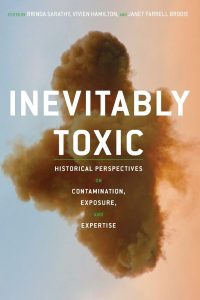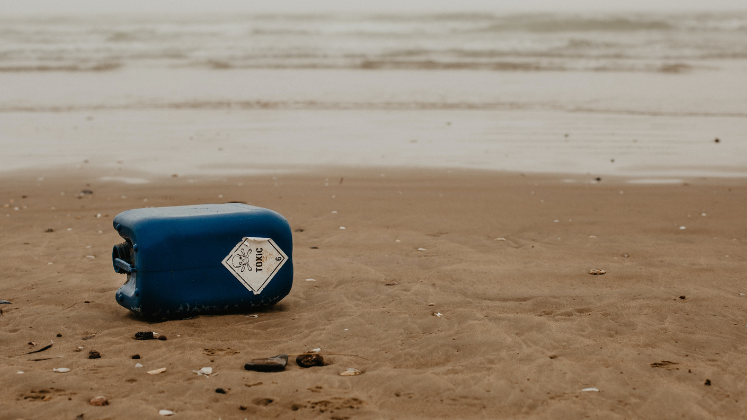In Inevitably Toxic: Historical Perspectives on Contamination, Exposure and Expertise, editors Brinda Sarathy, Vivien Hamilton and Janet Farrell Brodie bring together contributors in a timely call to place ‘toxicity’ back at the centre of public health discussions, exploring different toxic landscapes in North America and Japan to denaturalise the presence of inorganic contaminants in an environment. Revealing toxicity as the outcome of specific material and discursive practices that should be discussed and contested, the volume is an excellent addition to an emerging body of literature that raises vital questions about whose knowledge counts in the public debate over toxicity, writes Chiara Chiavaroli.
Inevitably Toxic: Historical Perspectives on Contamination, Exposure and Expertise. Brinda Sarathy, Vivien Hamilton and Janet Farrell Brodie (eds). University of Pittsburgh Press. 2019.
Find this book (affiliate link): ![]()
 ‘Radioactivity is not apparent to us through sight, taste or touch’ (295). Nevertheless, like industrial toxins and other inorganic contaminants, it is inscribed in many of the landscapes that we inhabit. In ‘being harmful, yet innocuous-looking’ (296), toxic environments are a crucial determinant of communities’ health and wellbeing. Simultaneously, obscured by political and scientific discourses aimed explicitly at opacity, toxicity often evades the public debate, failing to be recognised as a pressing public health issue.
‘Radioactivity is not apparent to us through sight, taste or touch’ (295). Nevertheless, like industrial toxins and other inorganic contaminants, it is inscribed in many of the landscapes that we inhabit. In ‘being harmful, yet innocuous-looking’ (296), toxic environments are a crucial determinant of communities’ health and wellbeing. Simultaneously, obscured by political and scientific discourses aimed explicitly at opacity, toxicity often evades the public debate, failing to be recognised as a pressing public health issue.
Inevitably Toxic brings together contributors in a timely call for placing ‘toxicity’ back at the centre of public health discussions. As argued by the film director Peter Galison in conversation with two of the editors, Brinda Sarathy and Vivien Hamilton, in the epilogue, toxicity is, in fact, an issue that ‘we cannot avoid’, even though, given its complexity, we might be incapable of solving it (299). The book is a collection of stories about different toxic landscapes in North America and Japan, ranging from the 1920s introduction of X-rays in the medical industry to contemporary environmental conflicts affecting Inuit communities in Canada. This historical gaze allows the authors of the different chapters to describe the socio-economic processes and ideological discourses that have allowed specific ‘environments of toxicity’ (5) to come into being. By denaturalising the presence of inorganic contaminants in the landscape, the book reveals toxicity as the outcome of specific and contextual material and discursive practices that can (and should) be discussed and contested.
In the first two sections of the book, the contributors analyse inorganic contaminants as the ‘by-products of industrial or military operations’ (11). The first section focuses on ‘Radiations’ and explores the employment of X-rays in medical technologies and nuclear weapons in the military industry, while the second examines ‘Industrial Toxins’ produced by the petrochemical industry as well as waste disposal and forest management practices. Moving beyond an understanding of toxicity as a contingency, toxic contaminants are claimed to be a direct material outcome of the Western political-economic system.
In Chapters Two and Four respectively, editor Janet Farrell Brodie and William Palmer explore the interplay between the military industry and discursive practices that celebrate notions of patriotism and secrecy, discussing the health costs that the employment of nuclear weapons generated for communities living near nuclear laboratory sites in the USA. In Chapters Six and Eight, Sarah Stanford-McIntyre and Bhavna Shamsunder respectively give two compelling examples of the interplay between the petrochemical industry and the economic development of West Texas and the Los Angeles area, offering insightful reflections on the impossibility of disentangling toxicity from local processes of economic growth. In these analyses, toxicity poses a compelling question concerning the sustainability of the ‘modern imperatives of technological progress and economic growth’ (5).

Understanding the role of ‘scientific expertise’ in the public debate over toxicity is a central aim of this collection. Other studies, such as Javier Auyero and Debora Alejandra Swistun’s ethnography of the Flammable shantytown in Argentina and Adriana Petryna’s post-disaster analysis of Chernobyl, have discussed the function that scientific institutions play in the process of uncertainty-making in toxic environments. Inevitably Toxic offers a further comparative and detailed look at the different scientific discourses that, more or less intentionally, hinder public processes of truth-seeking. Through the book, scientific expertise is found to contribute to obscuring truth to mitigate the community’s concerns, silence dissent or maintain military secrecy.
In the scientific discourses analysed by the contributors, communities’ concerns over their wellbeing become a ‘nuisance’ (141) and an obstacle to local and national economic growth. In Chapter Ten, Alexander Zahara describes the practices of institutional dismissal of ‘community-specific ways of knowing and being’ (262) in the context of the management of a dump fire in the Arctic Inuit territory of Iqaluit. The claims advanced by local grassroots movements, protesting over the decision to contain the fire while letting it burn, are delegitimised by a ‘deficit-style risk management framework’ (261). This framework classifies dissent as ‘the outcome of a public deficit in scientific and institutional knowledge and/or trust’ (261) while ignoring the possibility that the community’s perceptions of risk can be of any relevance. In Chapter Four, Palmer describes the rise of a new type of secrecy ‘where information was on display, yet still obscured’ (103), which raises concerns over transparency in the process of public decision-making.
Through the book, toxicity also gets delineated as a racial issue, and several contributors discuss the racially uneven distribution of contaminants in urban landscapes. In Chapter Six, Stanford-McIntyre argues that the Odessa petrochemical plant of West Texas brought significant economic gains for the local white middle class of oil workers and at the same time ‘reinforced the social marginalisation of the region’s Black and Latinxs populations’ (168). Such populations were materially excluded from jobs in the oil industry and underrepresented in the local discourse about the city and its plant as a white civic pride site. In Shamasunder’s analysis of Los Angeles oil drillings in Chapter Eight, both white communities and communities of colour are exposed to the contaminants generated by the oil industry, but ‘the distance between wells and their neighbours is closer than in wealthier and whiter neighbourhoods’ (209). More significant efforts in the ‘beautification’ (214) of oil plants were made in upper-class white districts. Moreover, this chapter gives an interesting analysis of the racialised dynamics that shaped local environmental movements and their diverging interests and the clashes and negotiations between mainstream environmental organisations, mostly constituted by white activists, and environmental justice grassroots movements emerging in communities of colour (218).
Moving the discussion to a transnational context, in Chapter Nine Naoko Wake proposes an interesting critique of the ‘nation-specific gendered understandings’ (235) of the Americans and the Japanese as the respective victors and victims of the atomic bombs in Hiroshima and Nagasaki. She illustrates the lack of assistance to Japanese American survivors that resulted from these limited nation-bound classifications and invites readers to question narrow notions of victimhood.
Readers may feel that the variety of the case studies analysed in this collection offers a somewhat fragmented perspective of the issue of toxicity. Indeed, a profound discussion that brings together the different chapters’ contents feels missing. Nevertheless, Inevitably Toxic is an excellent addition to an emerging body of literature that discusses the role of scientific knowledge in establishing imperfect, partial and uncertain ‘truths’ about the interplay between toxicity and public health. The question, raised through the book, of whose knowledge counts in the public debate over toxicity is exceptionally timely. The exercise of unpacking and discussing knowledge production practices undertaken by the contributors to this book can open the way for scholars from different disciplines to follow similar steps in questioning knowledge production mechanisms concerning environmental and health issues.
- This article originally appeared at the LSE Review of Books.
- Image Credit: Photo by Beth Jnr on Unsplash.
Please read our comments policy before commenting.
Note: This article gives the views of the authors, and not the position of USAPP– American Politics and Policy, nor of the London School of Economics.
Shortened URL for this post: https://bit.ly/2ONDRbb
About the reviewer
Chiara Chiavaroli – LSE International Development
Chiara Chiavaroli is a PhD student based at the Department of International Development at LSE. Her research focuses on links between environmental hazards and women’s health in extractivist landscapes in Colombia.



